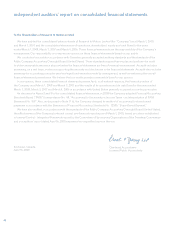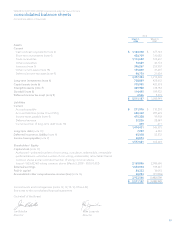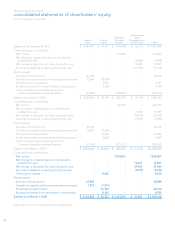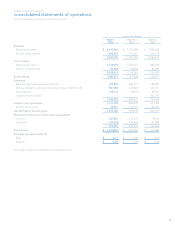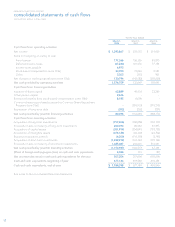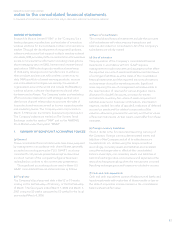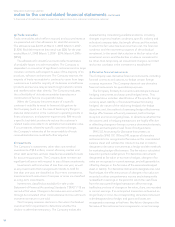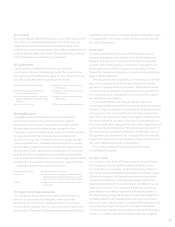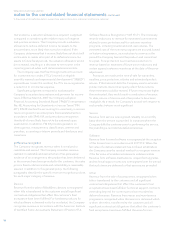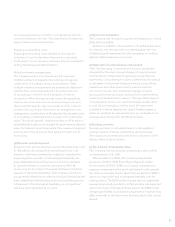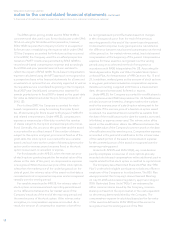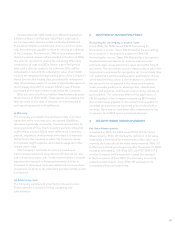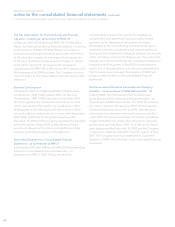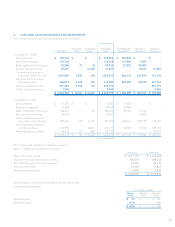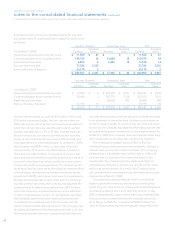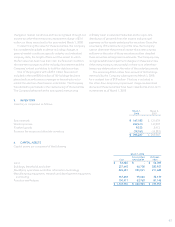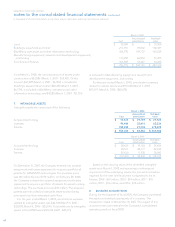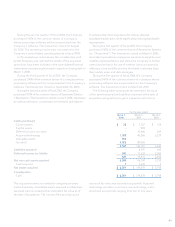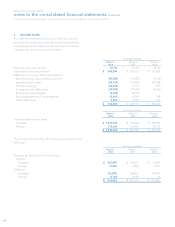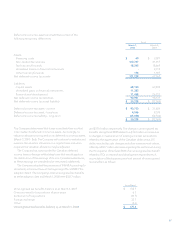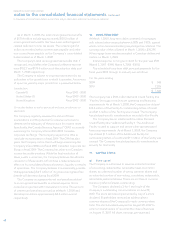Blackberry 2008 Annual Report Download - page 60
Download and view the complete annual report
Please find page 60 of the 2008 Blackberry annual report below. You can navigate through the pages in the report by either clicking on the pages listed below, or by using the keyword search tool below to find specific information within the annual report.58
RESEARCH IN MOTION LIMITED
notes to the consolidated financial statements continued
In thousands of United States dollars, except share and per share data, and except as otherwise indicated
be recognized each period fluctuates based on changes
in the closing stock price from the end of the previous
reporting period to the end of the current reporting period.
Compensation expense in any given period is calculated as
the difference between total earned compensation at the end
of the period (i.e. the vested intrinsic value), less total earned
compensation at the beginning of the period. Compensation
expense for these awards is recognized over the vesting
period using an accelerated method of recognition in
accordance with FASB Interpretation No. 28, Accounting for
Stock Appreciation Rights and Other Variable Stock Option
or Award Plan, An Interpretation of APB Opinions No. 15 and
25. In addition, realized gains on the exercise of stock options
in any given period are included as compensation expense.
Variable accounting is applied until there is a measurement
date, the award is exercised, forfeited or expires.
Under APB 25, the Company accounted for modifications to
stock options under FASB Interpretation No. 44. Modifications
include, but are not limited to, changes made to the number
and/or the exercise price of a stock option subsequent to the
grant date. If the exercise price of a fixed stock option award
is reduced, the award shall be accounted for as variable from
the date of the modification to the date the award is exercised,
is forfeited, or expires unexercised. The intrinsic value of the
award on the modification date is the difference between the
fair market value of the Company’s common stock on the date
of modification and the exercise price. Compensation expense
is recorded in the period of modification for the intrinsic value
of the vested portion of the award. Compensation expense
for the unvested portion of the award is recognized over the
remaining vesting period.
Under both APB 25 and SFAS 123(R), any consideration
paid by employees on exercise of stock options plus any
recorded stock-based compensation within additional paid-in
capital related to that stock option is credited to capital stock.
The Company has a Restricted Share Unit Plan (the “RSU
Plan”) under which eligible participants include any officer or
employee of the Company or its subsidiaries. The RSU Plan
was approved at the Company’s Annual General Meeting
on July 18, 2005 and received regulatory approval in August
2005. Restricted Share Units (“RSUs”) are redeemed for
either common shares issued by the Company, common
shares purchased on the open market or the cash equivalent
on the vesting dates established by the Company. The
compensation expense is calculated based on the fair value
of the award as defined in SFAS 123(R) and the amount is
recognized over the vesting period of the RSU.
The BSM option-pricing model used in SFAS 123(R) is
consistent with that used in pro forma disclosures under SFAS
123 Accounting for Stock-Based Compensation, however,
SFAS 123(R) requires the Company to factor in an expected
forfeiture rate in establishing the expense while under SFAS
123 the Company accounted for forfeitures as they occurred.
In fiscal 2007, the Company used the modified prospective
transition (“MPT”) method as permitted by SFAS 123(R) to
record stock-based compensation expense and accordingly
fiscal 2006 and prior periods have not been restated to
reflect the impact of SFAS 123(R). Stock-based compensation
expense calculated using the MPT approach is recognized on
a prospective basis in the financial statements for all new and
unvested stock options that are ultimately expected to vest as
the requisite service is rendered beginning in the Company’s
fiscal 2007 year. Stock-based compensation expense for
awards granted prior to fiscal 2007 is based on the grant-date
fair value as determined under the pro forma provisions of
SFAS 123.
Prior to fiscal 2007, the Company accounted for stock-
based compensation using Accounting Principles Board
No. 25 Accounting for Stock Issued to Employees (“APB 25”)
and related interpretations. Under APB 25, compensation
expense is measured as of the date on which the number
of shares subject to the option and exercise price becomes
fixed. Generally, this occurs on the grant date and the award
is accounted for as a fixed award. If the number of shares
subject to the option and grant price are not fixed as of the
grant date, the stock option is accounted for as a variable
award until such time as the number of shares subject to the
option and/or exercise prices becomes fixed, or the stock
option is exercised, is cancelled, or expires.
For fixed awards under APB 25, when the exercise price
of stock options granted equals the fair market value of the
shares on the date of the grant, no compensation expense
is recognized. When the exercise price of the stock options
is less than the market price of the underlying stock on the
date of grant, this intrinsic value of the award on that date is
recorded as stock compensation expense and is recognized
rateably over the vesting period.
For variable awards under APB 25, the intrinsic value of
stock options is remeasured each reporting period based
on the difference between the fair market value of the
Company’s stock as of the end of the reporting period and
the exercise price of the stock option. If the intrinsic value
is negative, no compensation expense is recorded. As a
result, the amount of compensation expense or benefit to


